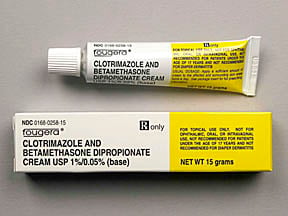
Clotrimazole-betamethasone Coupons & Savings Card – Discount Prices from $5.18
My prescription
Edit
15GM of 1-0.05%, Clotrimazole-betamethasone (1 Tube)
Select pharmacy

CVS
$19.37
COUPON PRICE
Walmart
$5.18
COUPON PRICE
Albertsons
$9.99
COUPON PRICE
Walgreens
$12.27
COUPON PRICEFree Clotrimazole-betamethasone Savings Card

Walmart
$5.18
Show this coupon to your pharmacist
ID
LH27E27706
PCN
CHIPPO
BIN
019876
GRP
LHX
This coupon is not insurance
More prescriptions for ringworm
More prescriptions for ringworm
Clotrimazole-betamethasone dosage forms
Dosage Quantity Price from Per unit 15GM of 1-0.05% 1 Tube $5.18 $5.18 15GM of 1-0.05% 2 Tubes $7.86 $3.93 15GM of 1-0.05% 3 Tubes $10.54 $3.51
| Dosage | Quantity | Price from | Per unit |
|---|---|---|---|
| 15GM of 1-0.05% | 1 Tube | $5.18 | $5.18 |
| 15GM of 1-0.05% | 2 Tubes | $7.86 | $3.93 |
| 15GM of 1-0.05% | 3 Tubes | $10.54 | $3.51 |
Clotrimazole-betamethasone Warnings
The following information outlines important safety considerations for the use of Lotrisone (clotrimazole / betamethasone). It is essential to understand these potential risks and precautions to ensure safe usage. Please discuss any concerns with your healthcare provider.
Altered Stress Hormone Levels: Prolonged use or application of Lotrisone over large skin areas may lead to excessive absorption, disrupting normal stress hormone levels. This can result in symptoms such as fatigue, nausea, and muscle pain. These effects typically subside upon discontinuation of the medication, though severe cases may require medical intervention. Be cautious if:
- Applying the medication to extensive body areas.
- Using it for extended durations.
- Covering the treated skin.
- Applying it on damaged skin.
- You have liver issues or are treating a child.
Cataracts and Glaucoma: Although infrequent, using Lotrisone may increase the risk of developing eye conditions like cataracts or glaucoma. Inform your healthcare provider of any pre-existing eye or vision problems before starting treatment. Report any new vision issues to your healthcare provider promptly. Risks include:
- A history of cataracts or glaucoma.
- Existing vision problems. These precautions are vital for minimizing potential complications while using Lotrisone. Always follow your healthcare provider's guidance and report any adverse effects immediately.
Clotrimazole-betamethasone Side Effects
Common side effects:
- burning
- tingling
- dry skin
- stinging
- tingling or numb sensation
- rash
- swelling
Serious side effects:
- extreme hair growth
- skin thinning or discoloration
- acne
- stretch marks
- small red bumps on the skin
- unusual tiredness
- weight loss
- headaches
- swelling of the ankles or feet
- increased thirst or urination
- vision problems
- rash, itching or swelling (especially of the face, tongue, or throat)
- severe dizziness
- trouble breathing
Clotrimazole-betamethasone Interactions
Interactions with high risk of serious adverse effects and should be avoided:
- Desmopressin
- Rotavirus Vaccine, Live
Interactions with moderate risk that may require dose adjustment, closer monitoring, or timing changes:
- Aceclofenac
- Acemetacin
- Aldesleukin
- Amtolmetin Guacil
- Balofloxacin
- Bemiparin
- Besifloxacin
- Bromfenac
- Bufexamac
- Bupropion
- Celecoxib
- Choline Salicylate
- Ciprofloxacin
- Clonixin
- Desogestrel
- Dexibuprofen
- Dexketoprofen
- Diclofenac
- Dienogest
- Diflunisal
- Dipyrone
- Drospirenone
- Droxicam
- Enoxacin
- Estradiol
- Ethinyl Estradiol
- Ethynodiol
- Etodolac
- Etofenamate
- Etoricoxib
- Felbinac
- Fenoprofen
- Fepradinol
- Feprazone
- Fleroxacin
- Floctafenine
- Flufenamic Acid
- Flumequine
- Flurbiprofen
- Gatifloxacin
- Gemifloxacin
- Gestodene
- Ibuprofen
- Indomethacin
- Ketoprofen
- Ketorolac
- Levofloxacin
- Levonorgestrel
- Lomefloxacin
- Lornoxicam
- Loxoprofen
- Lumiracoxib
- Lutetium Lu 177 Dotatate
- Macimorelin
- Meclofenamate
- Mefenamic Acid
- Meloxicam
- Mestranol
- Morniflumate
- Moxifloxacin
- Nabumetone
- Nadifloxacin
- Nadroparin
- Naproxen
- Nepafenac
- Niflumic Acid
- Nimesulide
- Nimesulide Beta Cyclodextrin
- Nomegestrol
- Norethindrone
- Norfloxacin
- Norgestimate
- Norgestrel
- Ofloxacin
- Oxaprozin
- Oxyphenbutazone
- Parecoxib
- Pazufloxacin
- Pefloxacin
- Phenylbutazone
- Piketoprofen
- Piroxicam
- Pranoprofen
- Proglumetacin
- Propyphenazone
- Proquazone
- Prulifloxacin
- Ritonavir
- Rofecoxib
- Rufloxacin
- Salicylic Acid
- Salsalate
- Sargramostim
- Sodium Salicylate
- Sparfloxacin
- Sulindac
- Tacrolimus
- Tenoxicam
- Tiaprofenic Acid
- Tolfenamic Acid
- Tolmetin
- Tosufloxacin
- Valdecoxib
Interactions with low risk that usually do not require a change in therapy:
- Aspirin
- Rifampin
- Phenobarbital
- Rifapentine
- Fosphenytoin
- Phenytoin
- Primidone
- Alcuronium
- Atracurium
- Auranofin
- Gallamine
- Hexafluorenium
- Licorice
- Metocurine
- Saiboku-To
- Trimetrexate
